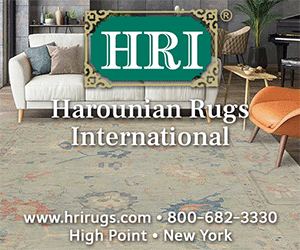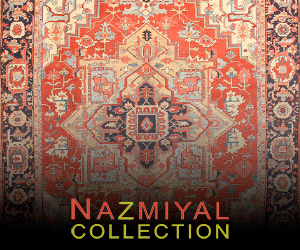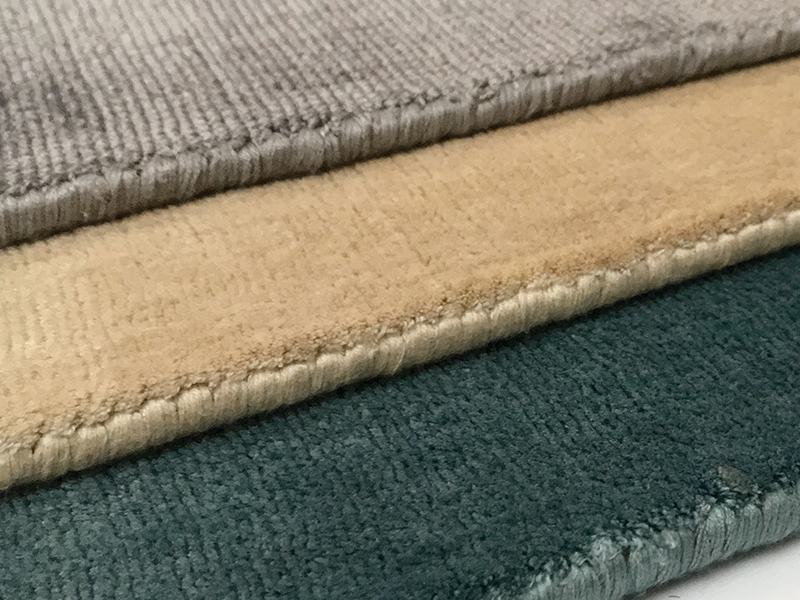The mere utterance of its name alone is enough to elicit controversy. On one hand there are those who love to hate upon it, on the other are those who embrace its use. Viscose, in its various forms, is increasingly used in rugs and carpets of multiple qualities. RUG INSIDER presents a daring look at both sides discussing its relative performance characteristics, situations unsuited for viscose, some key legal notes, and finally what makes a viscose carpet great.
Noted for its genuine silk-like qualities, viscose is a versatile fiber which purportedly has the same comfort properties as natural fibers. It can imitate the look and texture of wool, cotton, linen, and silk though most often in rugs it is the latter; it can be dyed and does not insulate heat which leaves the hand of viscose cool to the touch.
As such, viscose has and continues to be used in a wide range of consumer products from fashion, to personal care, to interiors, and as is appropriate herein, to rugs and carpets as well. And while no attempt to research the first appearance of viscose in rugs and carpets was made, an Indian manufacturer I spoke with who asked not to be identified by name, thusly called “Maker A”, stated that usage has greatly increased since 2008, especially in the past five to seven years. I also spoke with Yasir Sheikh, CEO of ALRUG with offices in Pakistan and the United States, who goes so far as to state, “I assume that Viscose is currently the third most common material used for handknotted rugs and its use is catching on among manufacturers. I expect to see more and more Viscose rugs in the future with maturing techniques and improvement in material over the next few years.” Further, even a perfunctory browse through online retailers and the websites of importers reveals a cache of viscose rugs on the market. It is thus safe to say the fiber is in wide use today in qualities ranging from machine-made as well as handloomed, to tufted and hand-knotted.
This brings the discussion to a metaphorical crossroads of sorts. To continue straight ahead would be to simply further document viscose and its uses, to turn right would be to espouse viscose as equal substitution for its naturally occurring counterparts glossing over its inherent faults, and to turn left would be to foreswear against the use of viscose claiming it anathema to any sound rug or carpet while ignoring situations in which viscose is a great material to use. As with most topics rug and carpet related the truth, if such a thing exists, lies more or less in the middle of this fictitious intersection if you will. Without passing judgment, here are various perspectives on viscose.
The use of viscose in rugs and carpets is, according to Sheikh, “dependent on the look and feel one is looking for and not in the cost.” Depending on the grade of viscose used, its cost can be comparable to some grades of wool, however when comparing a 100-percent natural silk carpet to a 100-percent viscose carpet of identical construction, the “Silk rug will always be more expensive.” according to Sheikh, and by this authors estimation is perhaps a 1/6 or less of the price of the silk at retail—again depending on the grade, that is quality, of viscose used. The look component though allows for viscose to be substituted for silk either as accent and highlight or as primary fiber thus approximating the aesthetic of a fully silk carpet. Across any type of construction when used as accent the cost of viscose plays a less important role, but for a full size 100-percent viscose carpet the cost savings can be significant as Sheikh alluded.
These nuanced distinctions are what make some people uncomfortable with this discussion for it centers heavily on perception. In the rug industry cinenascope-wide analysis there is a continuum of retail rug prices ranging from say $500 for a polypropylene machine-made 9x12 on Way-fair to an arbitrarily picked so-called luxurious pricepoint of $2,500 or $7,500 for a hand-knotted viscose 9x12. For those who might only spend $500 on a rug, the latter prices do seem luxurious, if not ludicrous, but the realist knows $2,500 is simultaneously inexpensive, even cheap to someone who would or could spend $10,000, $20,000, $30,000+ for something of comparable size; and people do.
But this is not just about whether some can or cannot afford it, it is also about whether someone chooses to afford it. Who in the rug industry has not heard a customer voice displeasure of price at veritably all levels? Someone may only want to spend $X on a carpet because that’s what they are comfortable spending especially the “current generation of consumers” for whom the purchase is “about aesthetics rather than intrinsic qualities associated with traditional materials.” This according to Maker A.
The physical characteristics of viscose yarns enable them to be dyed more or less side by side with its natural counterparts and as such it integrates easily into rug production environments, though it is worth noting manufactories must adapt and learn how to dye the fiber properly as to thoroughly set the dyes; running and crocking dyes are concerns with poor workmanship. Sheikh, Maker A, and another Pakistani maker who asked not to be identified, “Maker B” all concur viscose dyes well and produces yarn with rich vivid color. As an acceptable visual substitute for the more expensive silk, viscose—as the fiber technology exists today—is best used in lieu of this more precious material in applications where aesthetics and cost outweigh performance and longevity, this owing to viscose’s durability characteristics. As Sheikh succinctly states: “I would reserve the judgment on Viscose rugs as an option for short-term use and would rather see how the material improves over time.”
The durability, cleanability, and appearance retention of viscose is far lower than its more entrenched counterparts of wool and silk, especially when wet. A wool fiber will bend perhaps 10,000 times before breaking, silk 2,000, but viscose a mere 70-100, this according to Maker B. Viscose also exhibits low elastic recovery with some sources calling it the lowest of all fibers. By comparison: Viscose has an elasticity—that is its ability to be stretched and still return to its original shape—of approximately two to three percent whereas wool exhibits approximately thirty-percent when dry and up to fifty-percent when wet, the latter being in stark contrast to viscose’s decreased performance when wet. Some variants of viscose such as Tencel, the most recognized brand name of lyocell, provide increased strength and exhibit higher durability and appearance retention, though
from a cursory examination of rug and carpet labeling, no distinction in the type of viscose used can readily be discerned, save one: source of cellulose. Furthermore, the care and cleaning regimen for viscose as recommended by the American Fiber Manufacturers Association is “most viscose/rayon fabrics and yarns should be dry-cleaned” though the organization does note some variants of the fiber can be wet washed. Several importers note wet washing of viscose rugs may cause shrinkage, discoloration, or staining and as such special care must be exercised.
That notwithstanding viscose remains a perfectly acceptable, and genuinely laudable material for use in rug qualities where both silk-like aesthetics are required on a popular-priced budget and extended endurance is of lower importance. This is not to say however that wool or silk are the ultimate fibers, rather it is to say that specific fibers (and indeed constructions) have specific performance characteristics, that should be matched, either by the salesman, designer, or consumer, to specific applications. As an aside, this is something the contract and hospitality markets understand very well. Maker B is more direct stating, “If you want the rug to last indefinitely it is best to use it as a tapestry or wallhanging.”
The labeling of rugs and carpets, specifically their fiber content, raises a host of legal issues which have already played out in the court system of the United States. As viscose can be regenerated from any source of cellulose, firms seek to find a source that is both sustainable and low cost. Bamboo, because of its ability to grow prolifically worldwide with low effort, is a favorite source. Rugs and carpets made with viscose—and indeed any textile—must, as required by law and regulations set forth by the Federal Trade Commission (FTC) of the United States, be labeled as viscose or rayon. A firm may choose to further qualify with phrasing such as “viscose from bamboo” but in no instance where the fiber is viscose is labeling permitted which states solely bamboo or what have you. The FTC has published more information on this under the title: “How to Avoid Bamboozling Your Customers” and it is worth noting the labeling requirements are not restricted solely to those importing the carpets.
What all of this means to consumers—of all pricepoints and indeed levels in the supply chain—is that just as there are varying qualities of wool or silk, so too are their varying qualities of viscose. The performance characteristics of viscose as the broad fiber category it is, should be discussed, and just as a reputable dealer would not suggest a wool handknotted rug in an airport, so too are there situations in which viscose is inappropriate.
As Maker A concluded: “In a nutshell, I would say it [viscose] is a very good alternative to silk for those who cannot afford [or justify] the cost of silk.” Thus it is that viscose is a great material in situations wherein the rug or carpet will be replaced in comparably short order due to shifting design and aesthetic concerns and/or where a customer will only commit, for reasons aforementioned, to a budget that precludes silk. This is simply a balance of concerns and resources. At the same time, salespeople, websites, designers, anyone really, who is selling a viscose carpet should be honest about its composition, caveats, and benefits so the consumer can make an educated purchasing decision.
HEADER Image: RUG INSIDER file
Expanded story available in RUG INSIDER Spring 2018 Issue.





